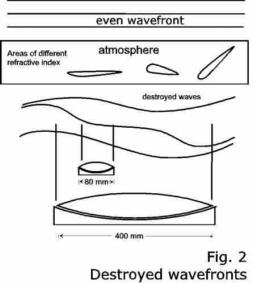 Deutsch Deutsch |
Turbulence of air - observation of Moon |
| Turbulence of air A cloudless sky is a condition for astronomical observations. A further substantial quality criterion is a low turbulence of air (so called seeing). Turbulences or random thermal motion of air are produced by thermionics causing density variations and thus air ranges with different optical refractive index. Such air cells can have sizes of some millimeters up to several 100 meters.  The light of far
astronomical objects reaches our atmosphere as even wave first. The
straight wave fronts are distorted by the different optical density which produces dynamic aberrations. We have to deal with local and temporal
deformations of the light waves. The resolution of fine structures at
the observation object is reduced. A star will twincle or dance,
expanded sources of light such as moon or sun appear out of focus at
various regions. You can reach sharp pictures using smaller lens
apertures: The cutout from the distorted wave reduces their variation.
Short observation times "freeze in" the dynamics of the object. However
both methods are counter productive with faint celestial bodies. Thus
low turbulence of air is a necessary condition for the observation of
astronomical objects. The following classification was provided by
Danjon and Courderc:
The light of far
astronomical objects reaches our atmosphere as even wave first. The
straight wave fronts are distorted by the different optical density which produces dynamic aberrations. We have to deal with local and temporal
deformations of the light waves. The resolution of fine structures at
the observation object is reduced. A star will twincle or dance,
expanded sources of light such as moon or sun appear out of focus at
various regions. You can reach sharp pictures using smaller lens
apertures: The cutout from the distorted wave reduces their variation.
Short observation times "freeze in" the dynamics of the object. However
both methods are counter productive with faint celestial bodies. Thus
low turbulence of air is a necessary condition for the observation of
astronomical objects. The following classification was provided by
Danjon and Courderc:R1: Sharp and calm pictures The maximum discrimination of the observation instrument is always reached. The strongest enlargements are possible. These nights occure only to two until three times a year and thus "a must" for the hobby astronomer. R2: Little flickering or slow waves The maximum discrimination of the observation instrument is reached for some seconds. You can accomplish detailed observations with the strongest enlargement for short times (some seconds of exposure time). R3: Fast oscillations, only short view on fine details The maximum discrimination of the observation instrument is reached for some tenth of a second. These conditions prevail approximately at 10 nights per month. For observation of Sun and Moon this condition is suitable, since you have strong light sources and do not need long exposure times. R4: Strong air turbulences, smearing the details This condition occures also 10 nights per month and can be accomplished for an observation without detail recognition when weak enlargement is used. R5: Constant air motion, observation is not possible at these nights You should go to bed and have a god night’s rest. Go back to my experiences Go back to sensitivity Go back moon observation (seeing) |
|
| Copyright by Hans Joachim Ilgen since 1950 | |